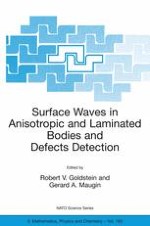2005 | OriginalPaper | Chapter
Complex Rays and Internal Diffraction at the Cusp Edge
Authors : M. Deschamps, O. Poncelet
Published in: Surface Waves in Anisotropic and Laminated Bodies and Defects Detection
Publisher: Springer Netherlands
Activate our intelligent search to find suitable subject content or patents.
Select sections of text to find matching patents with Artificial Intelligence. powered by
Select sections of text to find additional relevant content using AI-assisted search. powered by
It is well known that wave surfaces for anisotropic solids exhibit cuspidal behaviours in certain directions and that for isotropic solids these surfaces reduce to spheres. The wave surface is a locus of real rays which are normal to the slowness surface. Each ray is associated with a single homogeneous plane wave (or three ones for the cusp area), which is the only real solution (or three) for which the energy velocity is well oriented along the ray direction. For inhomogeneous plane waves, there exists an infinite number of solutions with a complex wavevector for a given ray direction. The damping vector (the imaginary part of the wavevector) is always normal to the energy direction and its amplitude can take any value. Although these complex rays exhibit correct directions of energy propagation they do not satisfy the Fermat’s principle. However, some of them are very close to satisfying this principle. Basing on this remark, an equation can be obtained to calculate the associated energy velocity. This intrinsic equation only refers to complex Christoffel equation. Limiting the study to principal planes and plotting the associated complex wave surface, it can be shown that four energetic rays always exist in any direction for both isotropic and anisotropic media (either beyond or inside the cusp). In other words, it is always possible to define four closed wave surfaces. Depending on the angles of energy propagation, either four surfaces are associated to real rays (cusp area), or two surfaces are associated with two real rays and two others with two complex rays. These angular areas are continuous and the distinctions appear at the cuspidal edges of wave surfaces. These calculations can easily explain the physical phenomena classically observed in these particular areas.
